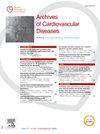Identification of a Nkx2-5 dosage-dependent progenitor cell population contributing to the Purkinje fiber network
IF 2.3
3区 医学
Q2 CARDIAC & CARDIOVASCULAR SYSTEMS
引用次数: 0
Abstract
Introduction
Cardiovascular diseases (CVDs) remain the leading cause of death worldwide, particularly in developed countries. Notably, approximately 50% of these deaths occur suddenly, often due to ventricular arrhythmias resulting from defects in the Purkinje fiber (PF) network. PFs are crucial for the rapid conduction of electrical impulses through the ventricles, ensuring the synchronized contraction of the heart. Despite their clinical relevance, the molecular mechanisms governing PF development and maturation are not fully understood. Our group has previously shown that PFs arise from embryonic trabecular myocardium, with their commitment to the PF fate being regulated by high levels of the transcription factor Nkx2-5. Genetic deletion of one copy of Nkx2-5 in mice results in a hypoplastic PF network, likely due to defective PF commitment during ventricular morphogenesis.
Objective
Building on this model, we aim to define the transcriptional landscape that governs PF commitment and maturation, both under normal and pathological conditions.
Method
1) Single cell transcriptomic analysis (scRNA-seq) from embryonic (E)11.5 WT and Nkx2–5 ± hearts. 2) Expression pattern and genetic lineage tracing of Lysozyme M (Lyz2), a novel PF marker.
Results
ScRNA-seq cluster and DEG analysis identifies a trabecular cardiomyocyte (CM) population expressing high levels of Lyz2 in WT but not Nkx2–5 ± E11.5 hearts. Intriguingly, Lyz2 expressing CMs (high Lyz2) co-express a subset of genes required for conductive CM commitment. Time-course lineage tracing analysis using a Lyz2-Cre driver reveals that Lyz2-derived CMs contribute to the VCS in adult WT hearts. In contrast, in Nkx2–5 ± hearts, Lyz2-derived cells only minimally contribute to the hypoplastic PF network.
Conclusion
Our results identify a progenitor cell population within the developing trabeculae that expresses high levels of Lyz2 and contributes to the formation of the VCS in an Nkx2–5-dependent manner.
浦肯野纤维网络中Nkx2-5剂量依赖性祖细胞群的鉴定
心血管疾病(cvd)仍然是世界范围内死亡的主要原因,特别是在发达国家。值得注意的是,这些死亡中约有50%是突然发生的,通常是由于浦肯野纤维(PF)网络缺陷引起的室性心律失常。PFs对于通过心室快速传导电脉冲至关重要,确保心脏的同步收缩。尽管它们具有临床意义,但控制PF发展和成熟的分子机制尚不完全清楚。我们的研究小组之前已经表明,PFs起源于胚胎小梁心肌,它们对PF命运的承诺受到高水平转录因子Nkx2-5的调节。在小鼠中,一个Nkx2-5拷贝的基因缺失会导致PF网络发育不全,这可能是由于在心室形态发生过程中PF承诺存在缺陷。在此模型的基础上,我们旨在确定在正常和病理条件下控制PF承诺和成熟的转录格局。方法1)胚胎(E)11.5 WT和Nkx2-5±心脏的单细胞转录组学分析(scRNA-seq)。2)新型PF标记物Lysozyme M (Lyz2)的表达模式及遗传谱系追踪。结果scrna -seq聚类和DEG分析发现,在WT中,小梁心肌细胞(CM)表达高水平的Lyz2,而在Nkx2-5±E11.5心脏中不表达。有趣的是,表达Lyz2的CMs(高Lyz2)共同表达传导性CM承诺所需的基因子集。使用Lyz2-Cre驱动程序的时间过程谱系追踪分析显示,lyz2衍生的CMs有助于成人WT心脏的VCS。相比之下,在Nkx2-5±心脏中,lyz2来源的细胞仅对发育不全的PF网络有最小的贡献。结论在发育中的小梁内发现了高水平表达Lyz2的祖细胞群,并以依赖nkx2 - 5的方式参与了VCS的形成。
本文章由计算机程序翻译,如有差异,请以英文原文为准。
求助全文
约1分钟内获得全文
求助全文
来源期刊

Archives of Cardiovascular Diseases
医学-心血管系统
CiteScore
4.40
自引率
6.70%
发文量
87
审稿时长
34 days
期刊介绍:
The Journal publishes original peer-reviewed clinical and research articles, epidemiological studies, new methodological clinical approaches, review articles and editorials. Topics covered include coronary artery and valve diseases, interventional and pediatric cardiology, cardiovascular surgery, cardiomyopathy and heart failure, arrhythmias and stimulation, cardiovascular imaging, vascular medicine and hypertension, epidemiology and risk factors, and large multicenter studies. Archives of Cardiovascular Diseases also publishes abstracts of papers presented at the annual sessions of the Journées Européennes de la Société Française de Cardiologie and the guidelines edited by the French Society of Cardiology.
 求助内容:
求助内容: 应助结果提醒方式:
应助结果提醒方式:


